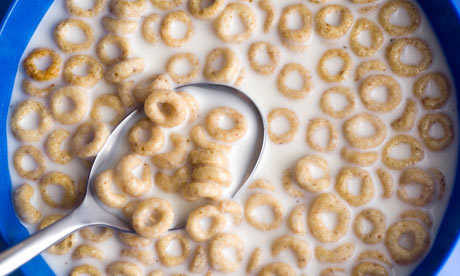Tests Show Monsanto Weed Killer in Cheerios, Other Popular Foods
by Carey Gillam
Independent testing on an array of popular American food products found many samples contained residue levels of the weed killer called glyphosate, leading the nonprofit organization behind the testing to call for corporate and regulatory action to address consumer safety concerns.
The herbicide residues were found in cookies, crackers, popular cold cereals and chips commonly consumed by children and adults, according to Food Democracy Now and the group's "Detox Project," which arranged for the testing at the San Francisco-based Anresco lab. Anresco uses liquid chromatography tandem mass spectrometry (LC-MS/MS), a method widely considered by the scientific community and regulators as the most reliable for analyzing glyphosate residues. The groups issued a report Monday that details the findings.
The announcement of the private tests comes as the Food and Drug Administration (FDA) is struggling with its own efforts to analyze how much of the herbicide residues might be present in certain foods. Though the FDA routinely tests foods for other pesticide residues, it never tested for glyphosate until this year. The testing for glyphosate residues was recently suspended, however. Glyphosate is under particular scrutiny now because last year the World Health Organization's International Agency for Research on Cancer (IARC) classified it as a probable human carcinogen. Glyphosate is the world's most widely used herbicide and is the key ingredient in Monsanto Co.'s branded Roundup, as well as in hundreds of other products. The Environmental Protection Agency is now finalizing a risk assessment for glyphosate to determine if future use should be limited.
The tests conducted by Anresco were done on 29 foods commonly found on grocery store shelves. Glyphosate residues were found in General Mills' Cheerios at 1,125.3 parts per billion (ppb), in Kashi soft-baked oatmeal dark chocolate cookies at 275.57 ppb, and in Ritz Crackers at 270.24 ppb, according to the report. Different levels were found in Kellogg's Special K cereal, Triscuit Crackers and several other products. The report noted that for some of the findings, the amounts were "rough estimates at best and may not represent an accurate representation of the sample." The food companies did not respond to a request for comment.
The EPA sets a "maximum residue limit" (MRL), also known as a tolerance, for pesticide residues on food commodities, like corn and soybeans. MRLs for glyphosate vary depending upon the commodity. Finished food products like those tested at Anresco might contain ingredients from many different commodities.
The nonprofit behind the report said that concerns about glyphosate comes as research shows that Roundup can cause liver and kidney damage in rats at only 0.05 ppb, and additional studies have found that levels as low as 10 ppb can have toxic effects on the livers of fish. The groups criticized U.S. regulators for setting an acceptable daily intake (ADI) at for glyphosate at much higher levels than other countries consider safe. The United States has set the ADI for glyphosate at 1.75 milligrams per kilogram of bodyweight per day (mg/kg/bw/day) while the European Union has set it at 0.3, for instance. The EPA is supposed to set an ADI from all food and water sources that is at least 100 times lower than levels that have been demonstrated to cause no effect in animal testing. But critics assert that the EPA's analyses have been unduly influenced by the agrichemical industry.
The groups said that the federal government should conduct an investigation into the "harmful effects of glyphosate on human health and the environment," and the relationships between regulators and the agrichemical industry that has long touted the safety of glyphosate.
Monsanto has said repeatedly that there are no legitimate safety concerns regarding glyphosate when it is used as intended, and that toxicological studies in animals have demonstrated that glyphosate does not cause cancer, birth defects, DNA damage, nervous system effects, immune system effects, endocrine disruption or reproductive problems. The company, which has been reaping roughly $5 billion a year from glyphosate-based products, says any glyphosate residues in food are too minimal to be harmful.
Both the U.S. Department of Agriculture and the FDA have echoed Monsanto's reassurances in the past, citing the chemical's proven safety as justification for not including glyphosate residue testing in annual programs that test thousands of food products each year for hundreds of different types of pesticides. But the lack of routine government monitoring has made it impossible for consumers or regulators to determine what levels of glyphosate are present in foods, and questions about the chemical's safety persist.
A key reason glyphosate residues persist in so many food products has to do with its widespread use in food production. Glyphosate is sprayed directly on several crops genetically engineered to tolerate the herbicide, such as corn, soybeans, sugar beets, and canola. Glyphosate is also sprayed directly on many types of conventional crops ahead of harvest, including wheat, oats and barley. In all, glyphosate is used in some fashion in the production of at least 70 food crops, according to the EPA, including a range of fruits, nuts and veggies. Even spinach growers use glyphosate. In the report issued Monday, the groups call for a permanent ban on the use of glyphosate as a pre-harvest drying agent because of the residue levels.
A recent analysis done by a senior FDA chemist found glyphosate residues in several types of oatmeal products, including baby food, and in several honey samples. The glyphosate residues found in honey were higher than allowed in the European Union.


